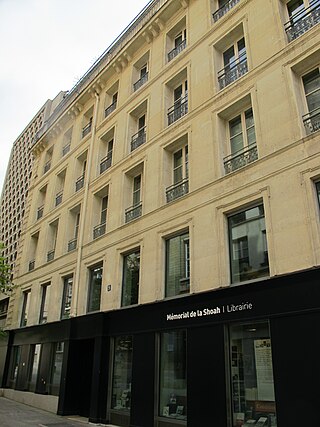
Mechelen is a city and municipality in the province of Antwerp in the Flemish Region of Belgium. The municipality comprises the city of Mechelen proper, some quarters at its outskirts, the hamlets of Nekkerspoel (adjacent) and Battel, as well as the villages of Walem, Heffen, Leest, Hombeek, and Muizen. The river Dyle (Dijle) flows through the city, hence it is often referred to as the Dijlestad.

Fort Breendonk is a former military installation at Breendonk, near Mechelen, Belgium, which served as a Nazi prison camp (Auffanglager) during the German occupation of Belgium during World War II.

On 19 April 1943, members of the Belgian Resistance stopped a Holocaust train and freed a number of Jews who were being transported to Auschwitz concentration camp from Mechelen transit camp in Belgium, on the twentieth convoy from the camp. In the aftermath of the attack, a number of other captives were able to jump from the train as well. In all, 233 people managed to escape, of whom 118 ultimately survived. The remainder were either killed during the escape or were recaptured soon afterwards. The attack was unusual as an attempt by the resistance to free Jewish deportees and marks the only mass breakout by deportees on a Holocaust train.

The history of the Jews in Belgium goes back to the 1st century CE until today. The Jewish community numbered 66,000 on the eve of the Second World War but after the war and the Holocaust, now is less than half that number.

Holocaust trains were railway transports run by the Deutsche Reichsbahn and other European railways under the control of Nazi Germany and its allies, for the purpose of forcible deportation of the Jews, as well as other victims of the Holocaust, to the Nazi concentration, forced labour, and extermination camps.

The Mechelen transit camp, officially SS-Sammellager Mecheln in German, also known as the Dossin barracks, was a detention and deportation camp established in a former army barracks at Mechelen in German-occupied Belgium. It served as a point to gather Belgian Jews and Romani ahead of their deportation to concentration and extermination camps in Eastern Europe during the Holocaust.
Kazerne Dossin is a former army barracks in Mechelen, Belgium, currently known as "Hof van Habsburg". It may refer to:

The FN Model 1905 or FN Model 1906 was a pistol manufactured by Fabrique Nationale de Herstal from 1906 to 1959.

The Holocaust in Belgium was the systematic dispossession, deportation, and murder of Jews and Roma in German-occupied Belgium during World War II. Out of about 66,000 Jews in the country in May 1940, around 28,000 were murdered during the Holocaust.

The Holocaust in the Netherlands was organized by Nazi Germany in occupied Netherlands as part of the Holocaust across Europe during the Second World War. The Nazi occupation in 1940 immediately began disrupting the norms of Dutch society, separating Dutch Jews in multiple ways from the general Dutch population. The Nazis used existing Dutch civil administration as well as the Dutch Jewish Council "as an invaluable means to their end".

Jan Vanriet, real name Jan Louis Lucien Vanriet, is a Belgian (Flemish) painter and poet.

Mémorial de la Shoah is the Holocaust museum in Paris, France. The memorial is in the 4th arrondissement of Paris, in the Marais district, which had a large Jewish population at the beginning of World War II.

Maxime Steinberg (1936–2010) was a Belgian historian and teacher who wrote extensively on the Holocaust in Belgium. He has been described as "Belgium's principal Holocaust historian" and was best known for his three-part history of the subject entitled L'Étoile et le Fusil, published in 1983–87.

Irene Awret or Irene Spicker (1921–2014) was a German artist, author and Holocaust survivor.

Meisjeshuis is a former children's home located at Albert Grisarstraat in Antwerp, Belgium. Throughout the years it has also been known as Adolf Stappaertsgasthuis and Algemeen Kinderziekenhuis Good-Engels.
Icek (Jacques) Glogowski, nicknamed 'le gros Jacques', was a Belgian Jew of Polish origin. Glogowski was an informant to the occupying authorities and Nazi collaborator in Belgium, responsible for the deportation of hundreds of Jews.
Eva Fastag was a Polish-born Holocaust survivor and resistant. During World War II, she was interned at the Mechelen transit camp.
The Sint-Erasmus hospital is a former hospital that was located at 33 Fonteinstraat in Antwerp, Belgium. In Dutch, it was known as Sint-Erasmusgasthuis.

Arthur Eugène Langerman false Swarzberg, known as Arthur Langerman, is a Belgian diamantaire. He is known for having gathered of one of the largest private collections of antisemitic images in the world. The collection constitutes the Arthur Langerman Archive for the Study of Visual Antisemitism (ALAVA) at Technische Universität Berlin in Germany.
















